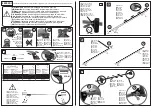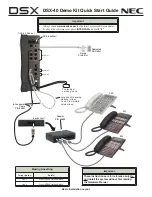
Avaya, Inc.
- 77 - PARTNER ACS 1600 DSL module User Guide
As shown in the equation below, this is equivalent to the
difference in the "relative transit time" for two packets: the
relative transit time
is the difference between a packet's RTP
time-stamp and the receivers clock at the time of arrival,
measured in the same units.
If
Si
is the RTP time-stamp from packet
i
, and
Ri
is the time of
arrival in RTP time-stamp units for packet
i
, then for two
packets
i
and
j
,
D
can be expressed as:
D(ij) = (Rj -Ri) -(Sj -Si) = (Rj -Sj) -(Ri -Si)
The interval jitter is calculated continuously as each data
packet
i
is received from source
SSRC-n
, using this difference
D
for that packet and of the previous packet
i-1
in order of
arrival (not necessarily in sequence), according to the formula:
J = J + ({D (i-l, i)} -J)/16
This value should only be set by your Network Administrator.
D. Display Jitter Delay
Displays the jitter delay value.
T. Set SLIC Control Mode
Displays the
SLIC Control Mode Selection
submenu, which
contains the following commands to set the SLIC Control
Mode:
A. AUTO Control Mode
B. MANUAL Control Mode
Select your choice.
Voice gateway applications, such as CopperCom or
JetStream, will override the value set by this command.
U. Set Compander Mode (u-Law, a-Law)
Displays the
Compander Mode Selection
submenu, which
contains the following commands to set the Compander
mode:
U. u-Law Mode
A. a-Law Mode
Select your choice.
If you are not sure which mode to use, check with your
telephone service provider. Normally, u-Law is used in North
America and a-Law in Europe.
















































